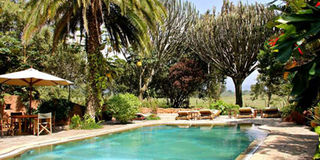RUPI MANGAT: Adventures by the lake

Chui Lodge swimming pool. PHOTO| RUPI MANGAT
What you need to know:
Hans, a retired banker, took to farming on a small piece of land on the shores of Lake Naivasha. His farm grew from a handful of employees tending a small vegetable farm, and turned into Oserian, a hallmark in Kenya’s flower industry.
Nicknamed the ‘flowering Dutchman’, Hans’ vision was to open corridors for the wildlife from Hell’s Gate National Park to the freshwater lake and beyond.
This is what led to the birth of Oserengoni Wildlife Sanctuary.
Standing on the crest of a hill in the Great Rift Valley, the view of the lake and all that surrounds it, is amazing. From that high vantage point, Lake Naivasha looks like three lakes but it’s actually two – the smaller salt water lake, Oloidien and the bigger freshwater lake, Naivasha, which is the highest lake in the valley.
On the shores bordering Lake Oloidien is Oserengoni Wildlife Sanctuary and Oserian – Kenya’s largest multi-crop flower farm.
I’m fascinated by all that’s going on in this little corner of the earth, beginning with the bush breakfast by Oloidien’s shores, which includes sparkling wine sipped amidst the sounds of African fish eagles and screeching colobus monkeys high in the yellow-barked acacias.
With many birds flying about, only the flamingoes are missing as they wait for the lake’s waters to reach the right level and for the algae to bloom.
“There’s not a single structure around Oserian’s lakeshores,” states John Ndegwa of Oserengoni Wildlife Sanctuary. The sanctuary was started by Hans and June Zwager and their son Peter Zwager in 1995, to conserve wildlife.
Hans and his wife June arrived at the spot where Oserian and Oserengoni stand today, and found a sprawling wheat farm with no wildlife.
Hans, a retired banker, took to farming on a small piece of land on the shores of Lake Naivasha. His farm grew from a handful of employees tending a small vegetable farm, and turned into Oserian, a hallmark in Kenya’s flower industry.
Nicknamed the ‘flowering Dutchman’, Hans’ vision was to open corridors for the wildlife from Hell’s Gate National Park to the freshwater lake and beyond.
This is what led to the birth of Oserengoni Wildlife Sanctuary.
With that brief history in mind, we continue with our leisurely breakfast. Later, we go on a drive and on reaching the main road, we find the resident giraffe taking a stroll. Motorists have to drive slowly past it because animals have the right of way.
A few minutes’ drive away through the gates of Oserian’s geothermal power plant on the crest of a hill, we wear white helmets in preparation for a tour around the neat little operation tucked away in the Leleshwa bushes. A 214-metre deep well generates all the energy for Oserian and nothing is left to waste. You wouldn’t even know there was anything like a geothermal power plant in the bush.
ROSE COUNTRY
After driving down to the plains, we go into a greenhouse filled with an unbelievable array of cut roses, from a peach-pink rose labelled ‘vuvuzela’ to commemorate the 2010 FIFA World Cup in South Africa, to the mottled red and white rose labeled ‘angry bird’. There are more than 90 other rose varieties. A million roses are cut per day for export.
It’s such a refined operation and we are taken through the journey of a rose from the time it is cut, to when it is sorted, packed and put on the road. It takes no more than 24 hours for it to reach the shelves of European and American supermarkets. Oserian is probably the most technologically-advanced flower farm in Kenya and from what I’m seeing they maintain a good working relationship with the staff.
The female workers get to leave their babies in a crèche close to their working station, while the older ones are schooled in-house.
Back in Chui Lodge, in the wildlife sanctuary, we go for an evening game drive. In the cool of the day, a male ostrich performs a mating dance showing his prowess to the females, while a herd of Grevy’s zebra grazes against the backdrop of the Mau escarpment.
As one of the rarest species on earth, Grevy’s zebra are from Kenya’s north where they continue to battle habitat loss and encroaching humans, but in the safety of Oserengoni, they breed freely. George, the lion, is still around and hopefully other cats will follow. In the Leleshwa bushes where once only wheat grew, another rare bird – the grey crested helmet shrike – finds a home.
“At Oserian, the whole issue is about sustainability,” says Ndegwa. “Our model is about conservation and trade – that it can be done with a proper management plan.”
CHARMING OSERENGONI
At Oserengoni Wildlife Sanctuary, you can either stay at Chui Lodge, a high-end lodge modeled as an African boma with luxury huts as bedrooms, or stay at Kiangazi House, a beautiful country home.
There are more than 300 bird species, including birds like the Somali ostrich that breeds with the Maasai ostrich.
Guests to the sanctuary are also allowed to tour Oserian (flower farm) as well as the geothermal plant that powers it, but you have to make a prior booking. For more information, log on to oserengoniwildlife.com




